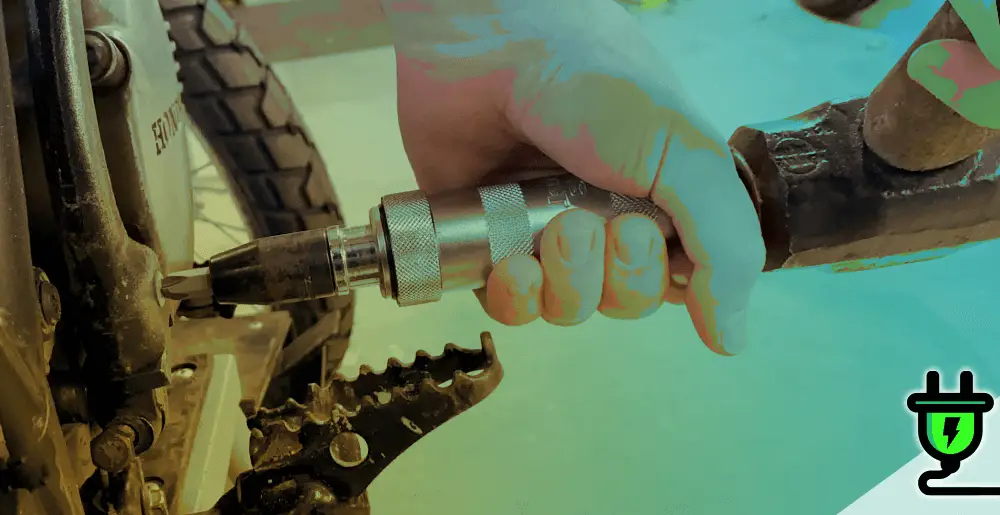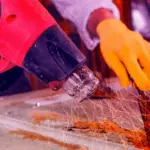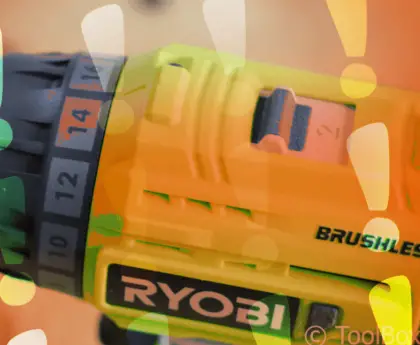Are you frustrated by stubborn screws and bolts that just won’t budge? But, how to use impact screwdriver alludes many. Don’t fear, we are here to help.
An impact screwdriver converts forceful impacts into rotational movement, aiding in loosening stuck screws or bolts. To use, select the appropriate bit then insert it into the screw head. Next, hold the tool perpendicular to the screw and strike the back of the screwdriver with a hammer. The tool turns slightly with each strike, loosening the screw.
An impact screwdriver, with its unique capability to deliver a strong rotational force, could be your saving grace to loosen stubborn screws.
This article will guide you through how to use impact screwdriverthe process effectively, making those tough fasteners a piece of cake. Let’s dig into this powerful tool and make your DIY projects easier!
Overview of an Impact Screwdriver
An impact screwdriver can be a lifesaver when it comes to removing stuck or stubborn screws. With its powerful mechanism, it can provide the extra force needed to get the job done.
How it works
An impact screwdriver changes a hit into a twist. It has parts like a spring, hammer and anvil. You push on the tool to set it up. This is called preloading the mechanism. Then you hit the end with a hammer.
The tool takes this push from the hammer and makes it into a fast turn. This quick spin helps to break free things that are stuck, like screws or bolts. The harder you hit, the faster it spins!
Purpose and benefits
An impact screwdriver is designed to loosen stubborn or stuck fasteners. It delivers a strong, sudden rotational force that helps break loose tight screws or bolts. The purpose of an impact screwdriver is to make your job easier by providing extra torque and power when traditional screwdrivers can’t do the job.
The benefits of using an impact screwdriver include saving time and effort, as well as being able to tackle tough fasteners that would otherwise require a lot of manual force. With its versatility and ability to work with different types of screws, an impact screwdriver is a valuable tool for various DIY projects and professional tasks alike.
Steps for Using an Impact Screwdriver
To begin, select the appropriate bit for the fastener you are working with and ensure it is securely inserted into the screwdriver. Then, prep the fastener by applying a firm grip on both the handle of the impact screwdriver and the fastener itself.
Next, deliver a hammer blow to apply force in either a clockwise or counterclockwise direction, depending on whether you need to tighten or loosen the screw. Finally, continue with steady pressure while turning in the desired direction until the screw is completely removed or tightened.
Selecting the right bit
To use an impact screwdriver effectively, it is crucial to select the right bit for the job. The bit should match the type and size of the fastener you are working with, such as a slotted, Phillips, or Torx screw.
Using the wrong bit can damage both the fastener and your tool. So make sure to choose a bit that fits securely into the fastener’s head without any wobbling or slipping. This will ensure that you have a firm grip and can apply force properly when using the impact screwdriver.
Prepping the fastener
To prep the fastener for loosening with an impact screwdriver, start by selecting the right size and type of bit that matches the screw or bolt you’re working on. This ensures a proper fit and prevents damage to both the fastener and the tool.
Once you have the correct bit, insert it into the stuck fastener firmly. Apply some clockwise pressure to preload the mechanism inside the impact screwdriver. This will help build up potential energy for when you apply force with a hammer blow later on.
Remember to hold onto the handle of the impact screwdriver securely while prepping the fastener to maintain control over your movements.
Applying force with a hammer
To apply force with a hammer when using an impact screwdriver, you need to firmly hold the handle of the tool and strike the end of it with a hammer. The impact from the hammer blow will transfer into the mechanism of the screwdriver, creating a sudden rotational force that helps loosen stuck fasteners.
It’s important to hit the end of the screwdriver in a clockwise or counterclockwise turn, depending on which way you need to remove or tighten the screws or bolts. This extra force generated by the impact makes it easier to work with stubborn fasteners and saves you time and effort.
Removing the screw
To remove a screw using an impact screwdriver, first make sure you have the right size and type of bit for the fastener. Then, insert the tip of the screwdriver into the screw head and apply slight pressure to preload the mechanism.
Next, give a firm hammer blow on top of the handle to create an impact force that loosens the stuck fastener. To unscrew it completely, turn the impact screwdriver in either a clockwise or counterclockwise direction depending on how it is threaded.
The impact force generated by this tool will make removing stubborn screws much easier and save you time and effort. Just remember to wear safety goggles to protect your eyes from any debris that may fly out during this process.
Tips for Effective Use
Get a good grip on the impact screwdriver for maximum control and power. Also, use proper technique by applying firm pressure with each hammer blow to ensure the screw loosens or tightens effectively.
To learn more about these tips, read on!
Getting a good grip
To ensure effective use of an impact screwdriver, it’s crucial to have a good grip on the tool. A firm and secure grip helps you maintain control and prevent accidents while applying force.
Make sure your hand is positioned comfortably around the handle, allowing for a strong hold. Additionally, wearing work gloves can improve your grip and protect your hands from any rough surfaces or sharp edges.
With a solid grip, you’ll be able to maneuver the impact screwdriver confidently and efficiently for all your fastening tasks.
Using proper technique
To use an impact screwdriver properly, start by selecting the right size and type of bit for your fastener. Make sure it matches to avoid damaging either the tool or the fastener. Next, prep the fastener by inserting the screwdriver tip into it firmly.
Then, apply force with a hammer blow to break loose the stuck fastener. Remember to turn the handle in a clockwise motion if you want to tighten a screw and counterclockwise if you want to loosen it.
Using proper technique ensures that you get optimal results and prevents any unnecessary damage or accidents while using an impact screwdriver.
Investing in quality bits
Investing in quality bits is essential when using an impact screwdriver. High-quality bits are more durable and less likely to break or strip, ensuring a smooth and effective operation.
They also provide a better grip on the fastener, reducing the risk of slippage and damage. Quality bits are designed to withstand the high torque generated by an impact screwdriver, allowing for efficient screw removal without compromising their lifespan.
By investing in quality bits, you can enhance the performance of your impact screwdriver and achieve optimal results in your DIY projects or professional tasks.
Common Mistakes to Avoid
- Applying too much force.
- Using the wrong size or type of bit.
- Neglecting safety precautions.
Applying too much force
Applying too much force when using an impact screwdriver can cause damage to the fastener or strip its threads. It’s important to remember that the impact force generated by the tool itself is already sufficient for loosening stuck fasteners.
By exerting excessive force, you may risk overtightening or breaking the fastener, which can lead to costly repairs or replacements. Always use a firm grip and apply just enough pressure to break the fastener loose without going overboard.
Using the wrong size or type of bit
Using the wrong size or type of bit can cause damage to both the fastener and the impact screwdriver. It’s important to choose a bit that matches the size and type of fastener you are working with.
If the bit is too small or too large, it may not fit properly in the fastener, resulting in a stripped or damaged screw head. Additionally, using an incorrect type of bit, such as a Phillips bit for a Torx screw, can also lead to ineffective results and potential damage.
To ensure successful and safe use of an impact screwdriver, always double-check that you have the right size and type of bit before starting your project.
Neglecting safety precautions
Always prioritize safety when using an impact screwdriver. One important precaution is to wear safety goggles to protect your eyes from any debris that may be produced during the impact.
Additionally, make sure to use the tool in a well-lit area and maintain a firm grip on the handle while using it. Remember to avoid using excessive force, as this can lead to accidents or damage to your workpiece.
By taking these safety measures, you can ensure a safe and successful experience with your impact screwdriver.
How to use impact screwdriver FAQs
How does an impact screwdriver work?
An impact screwdriver works by delivering sudden, rotational force to loosen or tighten screws. It uses a combination of downward force and rapid hammering motion.
What are the advantages of using an impact screwdriver over a regular screwdriver?
Using an impact screwdriver can make it easier to remove stubborn or rusted screws as the added force helps break them loose. It also reduces the need for excessive physical effort.
Can I use an impact screwdriver on any type of screw?
Yes, you can use an impact screwdriver on most common types of screws, including Phillips, flathead, and hex screws. However, some delicate or specialized screws may require alternative tools.
Is there anything I should be cautious about when using an impact screwdriver?
When using an impact screwdriver, be sure to wear safety goggles to protect your eyes from flying debris. Additionally, avoid applying excessive force that could damage the tool or strip the screw head
Conclusion: How to use impact screwdriver
So there you have it, using an impact screwdriver can make your DIY projects much easier. By selecting the right bit, prepping the fastener, and applying force with a hammer, you’ll be able to remove stubborn screws with ease.
Just remember to use proper technique, invest in quality bits, and prioritize safety precautions. With these tips, you’ll be a pro at using an impact screwdriver in no time!






